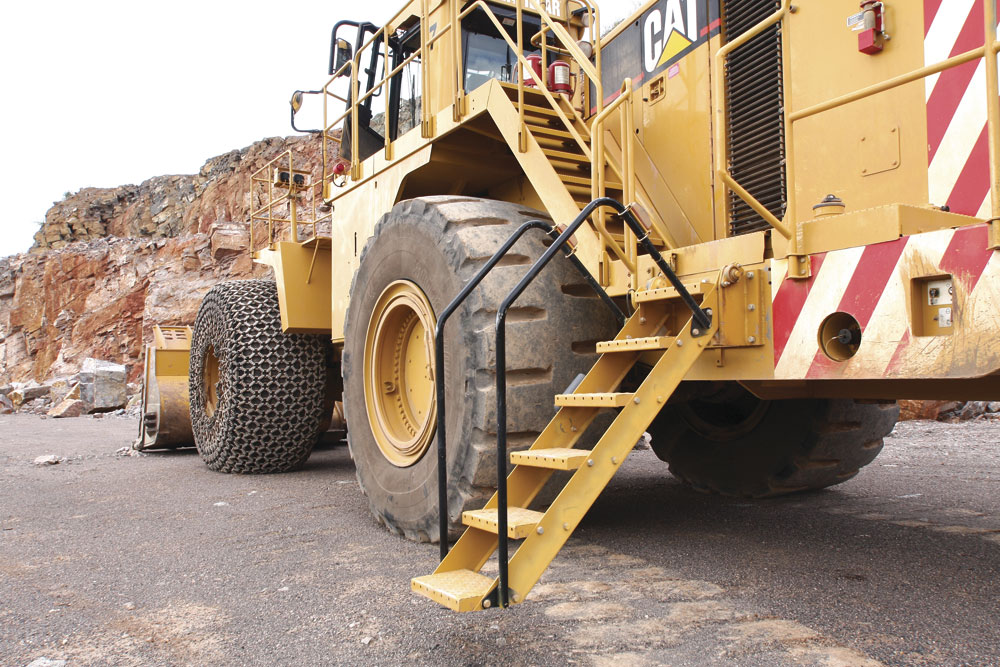‘Safer By Design’ Launched In UK

Voluntary best practice guidance for mobile plant
By Martin Isles, director, health and safety, Mineral Products Association
In a recent Mineral Products Association survey, ‘purchasing and design’ factors proved to be the second most important root cause of injury. This work confirmed the conclusions of the German Institute of Mining, at the Clausthal University of Technology, where 1,125 accidents were analysed.
Systemic shortcomings
While supporting national, European and international standards, it is apparent that the majority of new mobile plant placed legally on today’s market, CE-marked and therefore in compliance with the EU Machinery Directive, is not considered to reach the levels of safety required currently by many purchasing companies, without the addition of a significant list of user-specified ‘extras’.
In recognizing the fact that Standards will always lag best practice, organizations such as the MPA – and, in Australia, the Earth Moving Equipment Safety Round Table (EMESRT)1 – have concluded that there is a need to accelerate the development and adoption of best practice in machine designs to minimize the risk to health and safety through a process of end-user engagement with the original equipment manufacturers (OEMs) and suppliers. The MPA, EMESRT and others have a moral and professional duty to collate and disseminate best practice for the benefit of all stakeholders, not least to protect the lives and limbs of those individuals whose daily job is to operate or maintain mobile plant.
The MPA’s Hard Target has an overarching expectation of zero harm – this will not be achieved without the widespread adoption of best practices in the design of safer mobile plant. Although commendable progress has been made by the manufacturers in recent years, there remains much to be done. Lowest common denominator solutions are not helpful.
Voluntary best practice guidance for mobile plant
With financial support from the Aggregates Levy Sustainability Fund, voluntary best-practice guidance has been developed that defines the recommended range of safety features for new and re-engineered mobile plant. ‘Safer by Design’ involves working constructively with aggregate producing companies; the British Aggregates Association; Coalpro; and, vitally, around a dozen manufacturers and suppliers of mobile plant. While concentrating on the mineral products industry, there are closely analogous implications for construction and civil engineering.
Focusing on loading shovels, excavators, bulldozers, dumptrucks and mobile crushers and screens, the guidance is divided into five categories:
- Access systems
- Visibility
- Security
- Maintenance
- Environment, welfare and health
For each category, a range of criteria forms the nub of the resulting document identifying, for each machine group and size, whether an individual criterion is ‘Best practice’, ‘Optional’, ‘Aspirational’ or ‘Not applicable’.
Proactive mitigation of risk
The ‘Safer by Design’ spreadsheets now form the basis of a special new section on the industry’s acclaimed health and safety website, www.Safequarry.com. This presents a user-friendly, interactive approach to guiding manufacturers, suppliers, users, regulators – and, importantly, the workforce – as to best practice. The Code was launched in the UK at the MPA Health & Safety Awards in London on 6 October 2009. The video shown at the launch is freely accessible on Safequarry.com.
Support for the standards process
All partners involved in the ‘Safer by Design’ initiative understand the importance of, and fully support, the Standards process. Indeed, the MPA and its European equivalent, UEPG, are actively investigating ways of providing direct input to as many Standards Committees as possible, to ensure that today’s best practice becomes tomorrow’s standard practice. In reality, however, ‘tomorrow’ may be two, three, even five years into the future. In the interim, it is to the wider benefit of all stakeholders that the consensus views of the users are communicated via the ‘Safer by Design’ initiative, and acted upon.
Wide-ranging support
Companies involved in activities beyond the scope of the mineral products industry have expressed strong support for this voluntary ‘Safer by Design’ initiative. One example is the nationwide Hydrex Group, who operate approximately 1,300 items of mobile plant.
‘Safer by Design’ has been introduced to European audiences including representatives of the European Commission’s Enterprise Directorate; Employment & Social Affairs Directorate; CEN/TC151 Secretariat; and the European Trades Union Institute. Other European organizations, including those representing the manufacturers of mobile plant, although invited, were unable to attend. Further meetings are planned with manufacturers’ representatives, to build on the valued spirit of co-operation willingly proffered during the initiative’s formative stages.
Towards ‘Target Zero’
The road towards the ultimate target of zero harm cannot and will not be met unless all operational factors, including the supply chain procurement process, are addressed. Accordingly, the mineral products industry calls upon all stakeholders to contribute their expertise and goodwill to help, collectively, to prevent harm to any person involved in, or affected by, the use of mobile plant.
REFERENCE
1. http://www.mishc.uq.edu.au/index.html?page=58384


